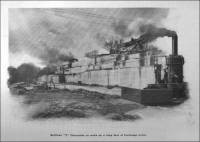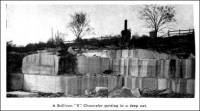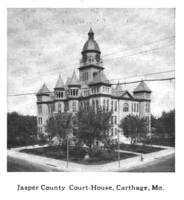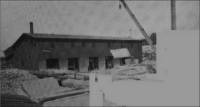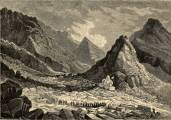


“Carthage Limestone: Its Production and Characteristics”
Written for Mine and Quarry By R. S. Strong, M.E., 265 Oak Street, Chicago.
In Mine and Quarry Magazine, February, 1908, Sullivan Machinery Co., Chicago, pp. 179-182.
Location and Character.
“Carthage, Missouri, is situated in the southwestern portion of the state, about 20 miles from Joplin. It is in the heart of the lead and zinc mining district of the southwest, but is known as well for its deposits of limestone, which are extensively worked, for building purposes. The quarries cover a tract of about 200 acres, and produced in 1906 a total of three-quarters of a million cubic feet of stone.
“The limestone is white, with a slight grayish tint, which is more restful to the eye than dead white. It is hard, being highly crystalline, and of a close, even texture. Analysis shows it to be almost pure carbonate of lime. Its components are:
Insoluble - 0.69
Oxides of iron and alumina (Fe2O Al2O3) - 0.21
Carbonate of Lime (CaCO3) - 98.57
Carbonate of Magnesia (MgCO3) - 0.65
(Total) - 100.12
(Figures of Missouri Bureau of Geology and Mines.)
“Tests give a crushing strength of 20,261 pounds to the square inch at right angles to the bed plane, and of 16,551 pounds to the square inch when the stone is on edge. The absorption of moisture is practically 0. These features make Carthage stone very desirable for buildings, flagging and other uses requiring severe wear. The stone weathers imperceptibly, and when used for steps or floors shows wearing qualities equal to those of granite. Carthage, a city of 15,000 inhabitants, is largely built of this beautiful white stone, which is used for sidewalks and curbing, as well as for residences, business and public buildings. Carthage is for this reason one of the most physically attractive cities in the southwestern central states. Carthage stone has also been shipped to Kansas City, St. Louis, and many other points where it is held in esteem. Most recently the waste stone has found a large demand for crushing purposes. It makes excellent concrete, and is desirable on account of its whiteness. The pulverized stone finds a varied market, being used as a filler for paint and putty, a soap powder, an asphalt surfacer, a metal polisher, a fertilizer, and a food for poultry.
Geology.
“Geologically speaking, these deposits belong to the Burlington group of the Mississippian Carboniferous strata. They are composed of the remains of crinoids and other shell-fish of the Silurian and Carboniferous epochs, whose forms may be readily traced throughout the beds. The ledges are horizontal and from three to 12 feet thick, the thickness increasing with depth. The ledges are separated by mud seams, which in some instances have been washed out, leaving hollows and caves of great interest to the geologist. Beds of flint nodules occur at several levels in the formation, but do not occasion large waste, as the stone is usually quarried along them.
Production: Channeling.
“The first step in opening a quarry is to strip the stone of its overburden of soil, flint, and cotton rock, aggregating 6 to 10 feet in depth. When working floor has been thus established, track channelers are installed, which make parallel cuts from 20 to 30 feet long and 10 feet apart. Cross channels are then run and the key-blocks removed. These blocks are broken away from the quarry bed by wedges driven into the channel cut, assisted by the derrick.
“The channelers commonly employed are the Sullivan single-gang direct-acting type, class ‘Y,’ although a few of the double-gang indirect-acting machines are still used for roughing work.
| A Sullivan Channeler in a well-developed quarry. Note the whiteness of the stone. (Photo caption, pp. 182) |  |
“The Sullivan channelers carry their own boilers, thus securing a constant supply of dry steam at 130 to 140 pounds pressure. The bit used, up to a depth of six feet, is composed of three pieces, each 1 ¼ x 2 ¼ inches: the outside steels cutting at right angles to the channel, and the center at an angle of 45 degrees. This arrangement permits the cut to be started with a gauge of from 2 ½ to 3 ½ inches, which is necessary on account of the depth of the cuts. Below six feet, the ordinary five-piece gang is used. These channelers cut two ledges at one lift, the depth ranging from six to 14 feet (see the photograph above, resulting in increased efficiency in production.
“The valve motion employed in these machines allows absolute and instantaneous control of the steam distribution, so as to give a heavy blow or a light tap as required. Carthage stone does not ordinarily show stunned or shattered edges under the channeler blow, but this difficulty sometimes occurs, and many cubic feet of valuable stone have been saved to the producer through the action of this valve. The former practice of considering the quarry bottomed upon the appearance of flint, due to the inability of earlier styles of channelers to cut this rock, was eliminated with the introduction of the hard-hitting Sullivan machines some seven years ago.
(PLEASE NOTE: I was unable to transcribe the rest of this article - Peggy B. Perazzo.)
Labor.
“The quarries employ from 250 to 300 men, who live in and near Carthage, the workings being within a mile or two of the business center. Stone cutters receive $4.50 per 12-hour day, machine-men 25 cents per hour, hoister and derrick engineers $2.00, and quarrymen $1.75 per day. Shipping facilities are excellent, since Carthage is on the Missouri Pacific, Iron Mountain, and Frisco lines.
Operators.
“The following quarry companies produce the greater part of the limestone quarried in the Carthage field:
“Carthage Superior Limestone Co., R. M. Richter, President and General Manager; G. S. Beimdick, Treasurer; C. H. Carter, Superintendent.
“Carthage Stone Co., Curtis Wright, President; J. W. Ground, Vice-President; W. R. Logan, Secretary and Treasurer; W. W. Wright, Assistant Secretary; James Logan, General Manager.
“Carthage Quarry Co., Eugene O’Keefe, president; F. W. STeadley, Vice-President; J. E. O’Keefe, Secretary and Treasurer; Martin A. McNerney, General Manager.
“Spring River Stone Co., H. C. Johns, owner and manager.
“Carthage Building Stone Co., A. H. Caffee, President; Geo. Allen, Vice-President; Millard Bryan, Secretary, Treasurer, and Superintendent; J. P. Newell, General Manager.
“Carthage Marble and White Lime Co., Geo. T. Riddle, President; Fred J. Remmers, Secretary; Henry Hatsfield, of St. Louis, General Agent; R. W. Jay, Superintendent of quarries.
“Missouri Stone and Construction Co., N. F. Wright, President and Manager, E. Powers, Vice-President; J. E. Hall, Secretary.
“Missouri Stone and Construction Co., N. F. Wright, President and Manager; E. Powers, Vice-President; J. E. Hall, Secretary.
“Myers Stone Co., W. B. Myers, President; Frank M. Myers, Vice-President and Manager.
“The demand for Carthage limestone is constantly increasing, and the quarries are kept at their full capacity to supply the market. An innovation of recent date is the introduction of natural gas as a fuel, in some of the quarries.
“At Phenix, Missouri, in Greene County, northeast of Carthage, the same grade of white limestone is quarried by similar methods to those employed in the Carthage district. Sullivan ‘Y’ Channelers are largely used. The chief operators in this locality are the Phenix Stone and Lime Co., Messrs. C. R. Hunt, President and General Manager, W. C. Searritt, Vice-President, and E. H. Jones, Secretary; and the Missouri Crystal Stone Co., Messrs. J. W. Lyman, President, J. H. Blair, Vice-President, H. A. Sutermeister, Secretary and Treasurer, and W. Delarue, Manager of the quarries. Both of these concerns have general offices in Kansas City, Mo. A description of the Phenix quarries will be published in a later number of Mine and Quarry.”
Commercial use of material within this site is strictly prohibited. It is not to be captured, reworked, and placed inside another web site ©. All rights reserved. Peggy B. and George (Pat) Perazzo.
